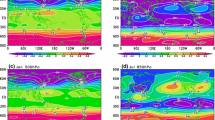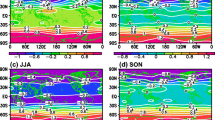Abstract
The three-pattern decomposition of global atmospheric circulation (TPDGAC) partitions three-dimensional (3D) atmospheric circulation into horizontal, meridional and zonal components to study the 3D structures of global atmospheric circulation. This paper incorporates the three-pattern decomposition model (TPDM) into primitive equations of atmospheric dynamics and establishes a new set of dynamical equations of the horizontal, meridional and zonal circulations in which the operator properties are studied and energy conservation laws are preserved, as in the primitive equations. The physical significance of the newly established equations is demonstrated. Our findings reveal that the new equations are essentially the 3D vorticity equations of atmosphere and that the time evolution rules of the horizontal, meridional and zonal circulations can be described from the perspective of 3D vorticity evolution. The new set of dynamical equations includes decomposed expressions that can be used to explore the source terms of large-scale atmospheric circulation variations. A simplified model is presented to demonstrate the potential applications of the new equations for studying the dynamics of the Rossby, Hadley and Walker circulations. The model shows that the horizontal air temperature anomaly gradient (ATAG) induces changes in meridional and zonal circulations and promotes the baroclinic evolution of the horizontal circulation. The simplified model also indicates that the absolute vorticity of the horizontal circulation is not conserved, and its changes can be described by changes in the vertical vorticities of the meridional and zonal circulations. Moreover, the thermodynamic equation shows that the induced meridional and zonal circulations and advection transport by the horizontal circulation in turn cause a redistribution of the air temperature. The simplified model reveals the fundamental rules between the evolution of the air temperature and the horizontal, meridional and zonal components of global atmospheric circulation.




Similar content being viewed by others
References
Archer CL, Caldeira K (2008) Historical trends in the jet streams. Geophys Res Lett 35:L08803. doi:10.1029/2008gl033614
Bayr T, Dommenget D, Martin T, Power SB (2014) The eastward shift of the Walker circulation in response to global warming and its relationship to ENSO variability. Clim Dyn 43:2747–2763. doi:10.1007/s00382-014-2091-y
Bowman KP, Cohen PJ (1997) Interhemispheric exchange by seasonal modulation of the Hadley circulation. J Atmos Sci 54:2045–2059. doi:10.1175/1520-0469(1997)054<2045:Iebsmo>2.0.Co;2
Charney JG (1947) The dynamics of long waves in a baroclinic westerly current. J Meteorol 4:135–162. doi:10.1175/1520-0469(1947)004<0136:TDOLWI>2.0.CO;2
Charney JG (1969) A further note on large-scale motions in the tropics. J Atmos Sci 26:182–185. doi:10.1175/1520-0469(1969)026<0182:AFNOLS>2.0.CO;2
Charney JG, Eliassen A (1949) A numerical method for predicting the perturbations of the middle latitude westerlies. Tellus 1:38–54. doi:10.3402/tellusa.v1i2.8500
Chen J, Carlson BE, Del Genio AD (2002) Evidence for strengthening of the tropical general circulation in the 1990s. Science 295:838–841. doi:10.1126/science.1065835
Chen S, Wei K, Chen W, Song L (2014) Regional changes in the annual mean Hadley circulation in recent decades. J Geophys Res 119:7815–7832. doi:10.1002/2014jd021540
Chou J (1974) A problem of using past data in numerical weather forecasting. Sci China Ser A 6:814–825
Chou J (1983) Some properties of operators and the effect of initial condition. Acta Meteorol Sin 41:385–392 (in Chinese)
Davis NA, Birner T (2013) Seasonal to multidecadal variability of the width of the tropical belt. J Geophys Res 118:7773–7787. doi:10.1002/jgrd.50610
Deng B, Liu H, Chou J (2010) An analysis on large-scale air–sea interactive linkages between the tropical Indian Ocean and the Pacific Ocean during ENSO events. J Trop Meteorol 16:305–312
DiNezio PN, Vecchi GA, Clement AC (2013) Detectability of changes in the Walker circulation in response to global warming. J Clim 26:4038–4048. doi:10.1175/Jcli-D-12-00531.1
Fu Q, Johanson CM, Wallace JM, Reichler T (2006) Enhanced mid-latitude tropospheric warming in satellite measurements. Science 312:1179. doi:10.1126/science.1125566
Held IM, Soden BJ (2006) Robust responses of the hydrological cycle to global warming. J Clim 19:5686–5699. doi:10.1175/Jcli3990.1
Holton JR (2004) Circulation and vorticity. In: Cynar F (ed) An introduction to dynamic meteorology, 4th edn. Elsevier, Amsterdam, pp 86–114
Hosking JS, Russo MR, Braesicke P, Pyle JA (2012) Tropical convective transport and the Walker circulation. Atmos Chem Phys 12:9791–9797. doi:10.5194/acp-12-9791-2012
Hu S (2006) The three-dimensional expansion of global atmospheric circumfluence and characteristic analyze of atmospheric vertical motion. Dissertation, Lanzhou University (in Chinese)
Hu S (2008) Connection between the short period evolution structure and vertical motion of the subtropical high pressure in July 1998. J Lanzhou Univ 44:28–32 (in Chinese)
Hu Y, Fu Q (2007) Observed poleward expansion of the Hadley circulation since 1979. Atmos Chem Phys 7:5229–5236. doi:10.5194/acp-7-5229-2007
Hu S, Chou J, Cheng J (2015) Three-pattern decomposition of global atmospheric circulation: part I—decomposition model and theorems. Clim Dyn. doi:10.1007/s00382-015-2818-4
Hu S, Cheng J, Chou J (2017) Novel three-pattern decomposition of global atmospheric circulation: generalization of traditional two-dimensional decomposition. Clim Dyn. doi:10.1007/s00382-017-3530-3
Karnauskas KB, Ummenhofer CC (2014) On the dynamics of the Hadley circulation and subtropical drying. Clim Dyn 42:2259–2269. doi:10.1007/s00382-014-2129-1
Kiladis GN, Feldstein SB (1994) Rossby wave propagation into the tropics in two GFDL general circulation models. Clim Dyn 9:245–252. doi:10.1007/BF00208256
Kiladis GN, Weickmann KM (1992a) Circulation anomalies associated with tropical convection during northern winter. Mon Weather Rev 120:1900–1923. doi:10.1175/1520-0493(1992)120<1900:Caawtc>2.0.Co;2
Kiladis GN, Weickmann KM (1992b) Extratropical forcing of tropical Pacific convection during northern winter. Mon Weather Rev 120:1924–1939. doi:10.1175/1520-0493(1992)120<1924:Efotpc>2.0.Co;2
L’Heureux ML, Lee S, Lyon B (2013) Recent multidecadal strengthening of the Walker circulation across the tropical Pacific. Nat Clim Change 3:571–576. doi:10.1038/Nclimate1840
Liu H, Hu S, Xu M, Chou J (2008) Three-dimensional decomposition method of global atmospheric circulation. Sci China Ser D 51:386–402. doi:10.1007/s11430-008-0020-9
Lu J, Vecchi GA, Reichler T (2007) Expansion of the Hadley cell under global warming. Geophys Res Lett 34:L06805. doi:10.1029/2006gl028443
Ma S, Zhou T (2016) Robust strengthening and westward shift of the tropical Pacific Walker circulation during 1979–2012: a comparison of 7 sets of reanalysis data and 26 CMIP5 models. J Clim 29:3097–3118. doi:10.1175/Jcli-D-15-0398.1
McGregor S, Timmermann A, Stuecker MF, England MH, Merrifield M, Jin FF, Chikamoto Y (2014) Recent Walker circulation strengthening and Pacific cooling amplified by Atlantic warming. Nat Clim Change 4:888–892. doi:10.1038/Nclimate2330
Mitas CM, Clement A (2005) Has the Hadley cell been strengthening in recent decades? Geophys Res Lett 32:L03809. doi:10.1029/2004gl021765
Nguyen H, Evans A, Lucas C, Smith I, Timbal B (2013) The Hadley circulation in reanalyses: climatology, variability, and change. J Clim 26:3357–3376. doi:10.1175/Jcli-D-12-00224.1
Oort AH, Peixóto JP (1983) Global angular momentum and energy balance requirements from observations. Adv Geophys 25:355–490. doi:10.1016/S0065-2687(08)60177-6
Rossby CG (1939) Relation between variations in the intensity of the zonal circulation of the atmosphere and the displacements of the semi-permanent centers of action. J Mar Res 2:38–55
Seidel DJ, Fu Q, Randel WJ, Reichler TJ (2008) Widening of the tropical belt in a changing climate. Nat Geosci 1:21–24. doi:10.1038/ngeo.2007.38
Sohn BJ, Park SC (2010) Strengthened tropical circulations in past three decades inferred from water vapor transport. J Geophys Res 115:D15112. doi:10.1029/2009jd013713
Sohn BJ, Yeh SW, Schmetz J, Song HJ (2013) Observational evidences of Walker circulation change over the last 30 years contrasting with GCM results. Clim Dyn 40:1721–1732. doi:10.1007/s00382-012-1484-z
Tokinaga H, Xie SP, Deser C, Kosaka Y, Okumura YM (2012) Slowdown of the Walker circulation driven by tropical Indo-Pacific warming. Nature 491:439–443. doi:10.1038/nature11576
Trenberth KE, Stepaniak DP (2003) Seamless poleward atmospheric energy transports and implications for the Hadley circulation. J Clim 16:3706–3722. doi:10.1175/1520-0442(2003)016<3706:Spaeta>2.0.Co;2
Vecchi GA, Soden BJ (2007) Global warming and the weakening of the tropical circulation. J Clim 20:4316–4340. doi:10.1175/JCLI4258.1
Wielicki BA et al (2002) Evidence for large decadal variability in the tropical mean radiative energy budget. Science 295:841–844. doi:10.1126/science.1065837
Xu M (2001) Study on the three dimensional decomposition of large scale circulation and its dynamical feature. Dissertation, Lanzhou University (in Chinese)
Yu B, Zwiers FW (2010) Changes in equatorial atmospheric zonal circulations in recent decades. Geophys Res Lett 37:L05701. doi:10.1029/2009gl042071
Zhang C, Webster PJ (1992) Laterally forced equatorial perturbations in a linear model. Part I: stationary transient forcing. J Atmos Sci 49:585–607. doi:10.1175/1520-0469(1992)049<0585:Lfepia>2.0.Co;2
Acknowledgements
This work was supported by the National Natural Science Foundation of China (41475068, 41475064, 41530531 and 41630421) and the Foundation of Key Laboratory for Semi-Arid Climate Change of the Ministry of Education in Lanzhou University. All of the authors express thank to the editor and anonymous reviewers for their useful suggestions and comments.
Author information
Authors and Affiliations
Corresponding author
Electronic supplementary material
Below is the link to the electronic supplementary material.
Rights and permissions
About this article
Cite this article
Hu, S., Cheng, J., Xu, M. et al. Three-pattern decomposition of global atmospheric circulation: part II—dynamical equations of horizontal, meridional and zonal circulations. Clim Dyn 50, 2673–2686 (2018). https://doi.org/10.1007/s00382-017-3763-1
Received:
Accepted:
Published:
Issue Date:
DOI: https://doi.org/10.1007/s00382-017-3763-1




